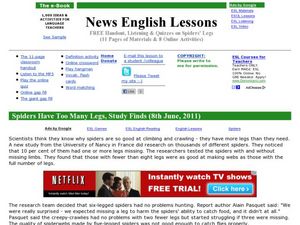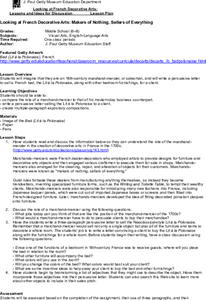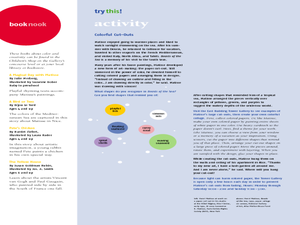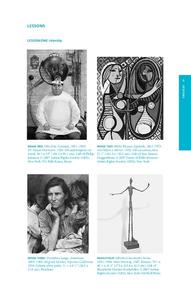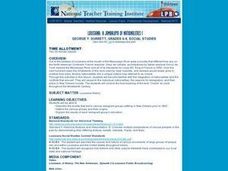Curated OER
A "Clear and Present Danger"
Students define what is meant by clear and present danger. In this First Amendment instructional activity, students listen to their instructor present a lecture regarding the details of the Sedition Act of 1798. Students consider...
Curated OER
Spiders Have Too Many Legs, Study Finds
Students explore current events by answering study questions about an article. In this arachnids lesson, students read a recently published article which discusses the importance of spiders and their 8 legs. Students answer study...
Curated OER
Constructing Things
Learners analyze the history and art in the Constructivism movement. In this art analysis lesson, students analyze and consider the material types in the art form. Learners complete image based discussion. Students work in groups using...
Curated OER
Portraiture
Students explore the conventions of portraiture and the technique of photo-montage. For this art analysis lesson, students define portraiture and analyze the pictured pieces of art. Students make a photo-montage portrait or caricature as...
Curated OER
Painting - Science Integration - Ponds - Monet - Painting
First graders identify Monet as an Impressionist artist. They create impressions of trees and bushes, paint with sponges, and mix tints and shades. They create impressions of flowers with q-tip dabbing and mixing tints and shades.
Curated OER
Looking at French Decorative Arts
Students compare the role of a marchand-mercier to that of a modern-day business counterpart and write a persuasive letter. In this French art lesson, students discuss the role of the marchand-mercier in French design and role-play his...
Curated OER
Looking at French Decorative Arts: Makers of Nothing, Sellers of Everything
Students imagine they are a 'marchand-mercier' (or salesman) and write a persuasive letter to sell French items. In this art analysis lesson plan, students identify the role of a 'marchand-mercier' and write a three-paragraph letter to...
Curated OER
Checkmate: What is the History of Chess?
Students create a timeline. In this history of chess lesson, students use the Internet to examine the chess history timeline. Students read books on the history of chess, answer questions and create a timeline using a...
Curated OER
Transforming Everyday Objects
Students analyze Pop artists and their art. In this art analysis lesson, students consider the choices and mediums Pop art artists Andy Warhol, Roy Lichtenstein, Claes Oldenburg, and Jasper Johns. Students make connections between...
Curated OER
The Oblate Sisters of Providence and Early African American Education in Baltimore
Eighth graders examine the educational system for free African-Americans in Baltimore in the early 19th century. In this American History lesson, 8th graders read a handout and answer focus questions. Students analyze...
Curated OER
What Weather When and Where?
Students learn the difference between hard news and feature writing. They choose one of these news styles to write a compelling weather-related article based on interviews with local sources.
Curated OER
The Trip of the Speedwell and the Mayflower
Fourth graders investigate the hardships Pilgrims faced on the Mayflower and Speedwell. In this Pilgrim lesson, 4th graders listen to an account of the Pilgrim's voyage from Plymouth, England to present day Massachusetts. Students sit in...
Curated OER
Popular Culture
Students analyze the period of Belle Epoque and the methods of art that signified popular culture. In this art analysis lesson, students consider the ways popular culture influenced art by analyzing the images and completing image based...
Curated OER
Molly's Pilgrim
Third graders recognize and discuss multi-ethnic nature of America's citizens through a variety of activities.
Curated OER
Positive/Negative Shapes, Shamrocks And Matisse
Students create Shamrock mobiles or art pieces using positive and negative shapes, card stock, glue, and the techniques used by Henri Matisse. The lesson includes many resource links and is a great project for St. Patrick's Day.
Curated OER
Justice in America
Eleventh graders analyze primary sources for evidence of intent and purpose. In this American government lesson, 11th graders compose a one-page response explaining their understanding of "justice." Students read and examine quotes about...
Curated OER
Deciphering the Declaration of Independence
Students explore the textual meaning of the Declaration of Independence. In this Declaration of Independence lesson, students read and paraphrase the text of the document into modern-day language. Students also consider the meaning of...
Curated OER
Colorful Cut-Outs
Students examine the works of Claude Matisse. In this Matisse Art Lesson, students explore Beasts of the Sea to find recognizable shapes. Students visit the National Gallery to view Matisse artworks.
Curated OER
Identity
Students analyze identify in art. In this art analysis lesson, students discuss what identify means and discuss how Otto Dix, Pablo Picasso, Dorothea Lange, and Alberto Giacometti represent identities in portraiture. Students complete...
Curated OER
Politics and Portraiture
Students examine the art of artists who use portrait drawing to make a political statement. For this art analysis lesson, students discuss the elements of a portrait and view the portraits as political expressions. Students complete...
Curated OER
GAURI AND PRITHVI: THE SUB-CONTINENT GOES NUCLEAR
Young scholars write short papers on the background of the Pakistani missile called Gauri, named for one of the first Afghan military invaders of India in 11th century, Prithvi is named for Hindu general who fought Muslim invaders, Agni...
Curated OER
Louisiana: a Jambalaya of Nationalities
Students write letters of protest outlining the reasons why abolishment of the Code Noir was going to have an adverse affect on political tensions in Louisiana.
Curated OER
Family Responsibility and Commitment
Students are introduced to Picasso and how he created Baboon and Young, and interpret the expressive content of the work. They discuss and define what a family unit consists of, and form conclusions of their own. Students identify and...
Other popular searches
- Hierarchy of New France
- New France in Canada
- Settlement of New France
- New France History
- New France Louisiana
- Conquest of New France
- Colonial New France
- New France Lessons
- New France Society
- New France Lesson Plans
- New France Lousiana
- Jesuits in New France



